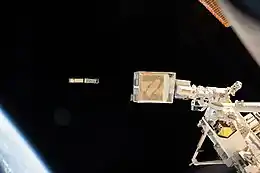 Deployment of CXBN-2 with IceCube | |
| Mission type | X-ray astronomy |
|---|---|
| Operator | Morehead State University |
| COSPAR ID | 1998-067LM[1] |
| SATCAT no. | 42704[2] |
| Website | CXBN-2 |
| Mission duration | April 18, 2017 – March 1, 2019 |
| Spacecraft properties | |
| Spacecraft | CXBN-2 |
| Spacecraft type | 2U CubeSat |
| Manufacturer | Morehead State University |
| Dry mass | 2.8kg |
| Dimensions | 10 x 10 x 20 cm |
| Power | 15W |
| Start of mission | |
| Launch date | April 18, 2017 |
| Rocket | ULA Atlas-5 401 |
| Launch site | Cape Canaveral Space Launch Complex 41 |
| Contractor | United Launch Alliance via ELaNa |
| Deployed from | International Space Station |
| Deployment date | May 16, 2017 |
| End of mission | |
| Disposal | Re-entry |
| Last contact | March 1, 2019[3] |
| Decay date | March 1, 2019 |
| Orbital parameters | |
| Reference system | Geocentric |
| Regime | Low Earth |
| Altitude | ~400 kilometres (250 mi)[4] |
| Inclination | 51.6°[4] |
| Transponders | |
| Band | UHF, S band |
| Instruments | |
| Cadmium Zinc Telluride (CZT) detector, magnetometer | |
Cosmic X-ray Background Nanosatellite-2 (CXBN-2 or CXBN 2) was a satellite and mission developed by the Morehead State University to follow up on the CXBN mission launched in 2012. It was an improved version of the previous spacecraft and it increased the precision of measurements of the cosmic X-ray background in the 30-50 keV range and helped to improve understanding of the early universe.[5][6]
Objectives
The CXBN-2 mission was created in order to map the extragalactic cosmic X-ray background with the use of a Cadmium Zinc Telluride (CZT) detector. Compared to its predecessor, its CZT detector had twice the detection area. It allowed for a new, high-precision measurement of the X-ray background.[4] It helped improve understanding of the origin and evolution of the universe through research on high-energy background radiation. It collected 3 million seconds of data throughout its lifetime.[5]
Design
The CXBN-2 satellite was a Sun-pointing spin-stabilized 2U CubeSat which had four solar panels which provided 15W of power. It had a 2-wall structure and braces to reinforce its body. When it was in its compact form, it occupied a volume of 10 x 10 x 20cm.
It had two transceivers in the Ultra high frequency and S bands for radio communication.[4]
Instruments
CXBN-2 contained a Cadmium Zinc Telluride Array as its X-ray detector and a magnetometer on board.[4]
Launch and mission
.jpg.webp)
Cygnus OA-7 launched on April 18, 2017 as the eighth flight of the Cygnus Orbital ATK uncrewed orbital spacecraft and its seventh flight to the International Space Station (ISS) under NASA's Commercial Resupply Services.[7] On April 22, 2017, the Cygnus spacecraft docked with the ISS.[8]
On May 16, 2017, the CXBN-2 satellite was deployed from the ISS via the Nanoracks CubeSat Deployer along with several other CubeSats.[9] On March 1, 2019, it re-entered the Earth's atmosphere.[3]
References
- ↑ "CXBN 1, 2 (Unbridled Spirit)". Gunter's Space Page. Retrieved 2021-12-04.
- ↑ "Technical details for satellite CXBN-2". N2YO.com - Real Time Satellite Tracking and Predictions. Retrieved 2021-12-06.
- 1 2 Kulu, Erik. "CXBN 2 @ Nanosats Database". Nanosats Database. Retrieved 2021-12-04.
- 1 2 3 4 5 "CXBN-2 | Satellite Directory | eoPortal". directory.eoportal.org. Retrieved 2021-12-04.
- 1 2 "Morehead State University :: Space Missions - CXBN-2". Morehead State University. Archived from the original on 2017-04-04. Retrieved 2021-12-04.
- ↑ Astrowatch.net. "CXBN-2 CubeSat to embark on an important X-ray astronomy mission". phys.org. Retrieved 2021-12-04.
- ↑ "Launch Log (2017-2018) – Spaceflight Now". Retrieved 2021-12-05.
- ↑ "S.S. John Glenn OA-7 Cygnus berthed to ISS". SpaceFlight Insider. 2017-04-22. Retrieved 2021-12-05.
- ↑ "CubeSat Deployer Mission 11 Status Update: Good Deploy!". Nanoracks. 2017-05-17. Retrieved 2021-12-05.